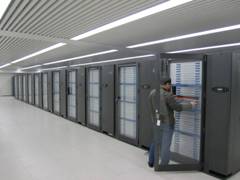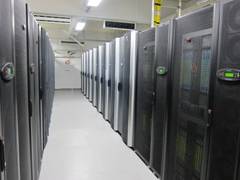
La classifica "Green500" elenca i supercomputer con la maggiore efficienza energetica del mondo e la nuova edizione aggiornata, pubblicata proprio oggi, è guidata da sistemi basati su GPU NVIDIA Tesla, gli unici di classe petaflop di questa speciale graduatoria.
Tra questi sistemi petaflop basati su GPU, Tsubame 2.0, creato dal politecnico di Tokyo (Tokyo Tech), si classifica al secondo posto, mentre Tianhe-1A, il supercomputer più veloce del mondo creato dal National Supercomputer Center di Tianjin, si classifica in decima posizione.
"L'ascesa meteorica dei supercomputer basati su GPU nella Green500 significa che i sistemi eterogenei, realizzati sfruttando sia le GPU che le CPU, sono in grado di garantire prestazioni da primato e valori senza precedenti di efficienza energetica", ha dichiarato Wu-chun Feng, fondatore della Green500 e professore associato di informatica alla Virginia Tech.
Le GPU si sono rapidamente dimostrate la tecnologia più importante per i supercomputer più potenti del mondo. Questi processori contengono centinaia di core di elaborazione in parallelo e sono in grado di suddividere i calcoli più imponenti e impegnativi e di elaborarli simultaneamente. Questa procedura assicura un nettissimo incremento dell'efficienza di tutti i sistemi, misurata dalle performance per Watt. I supercomputer "Top500" basati su architettura eterogenea sono, in media, quasi tre volte più efficienti in tema di consumo energetico rispetto ai sistemi non eterogenei.
Altri due sistemi basati su GPU Tesla sono entrati nella Top 10, mentre quelli installati allo CSIRO in Australia e al National Supercomputer Center di Shenzhen si sono classificati rispettivamente in undicesima e dodicesima posizione.
Questa settimana, molti dei responsabili dei centri di supercomputing presenti nella classifica Green500 presenziano alla conferenza SC’10 di New Orleans. Ecco i loro commenti:
Dichiarazioni:
Il prof. Satoshi Matsuoka del Tokyo Tech ha affermato: "Il nostro obiettivo per Tsubame 2.0 era quello di fornire prestazioni petaflop contenendo al massimo il consumo energetico. È stato ben presto evidente che passare alle GPU Tesla era l'unica strategia possibile per ottenere questo risultato."
Il dott. Jeffrey Vetter della Georgia Tech e degli Oak Ridge National Laboratory ha dichiarato: "Keeneland è il banco di prova per attività di sviluppo software estese alla ricerca e all'industria. Grazie all'uso delle GPU e delle architetture eterogenee, stiamo aprendo la strada a soluzioni di computing che coniugano prestazioni exaflop e contenimento del consumo energetico."
Il dott. Gareth Williams dello CSIRO, in Australia, ha aggiunto: "Con l'aiuto delle GPU, siamo riusciti a sviluppare il supercomputer più rapido ed efficiente dal punto di vista energetico dell'intera Australia. Grazie a questo tipo di risorsa di calcolo, saremo in grado di accelerare nettamente il ritmo delle nostre ricerche."
"Il superlativo valore di performance per Watt delle GPU Tesla le ha rese l'architettura di supercomputing per eccellenza, dato sottolineato dal fatto che i supercomputer basati su GPU siano gli unici sistemi di classe petaflop della Top 10", ha dichiarato Andy Keane, General Manager della divisione Tesla di NVIDIA. "Ci congratuliamo con tutti i centri che hanno ricevuto il riconoscimento dell'inserimento nella classifica Green500 di quest'anno."
Per la versione completa della classifica Green500, visitate questo indirizzo, mentre per avere altre informazioni sui prodotti di GPU Computing ad alte prestazioni NVIDIA Tesla , potete visitare questo indirizzo.

[Immagine ad alta risoluzione]

[Immagine ad alta risoluzione]

The "Green500" list of the world's most energy-efficient supercomputers was released today, revealing that the only petaflop systems in the top 10 are powered by NVIDIA Tesla GPUs.
Of these GPU-powered petaflop systems, Tsubame 2.0, from Tokyo Institute of Technology (Tokyo Tech), was ranked number two; and Tianhe-1A, the world's fastest supercomputer from National Supercomputer Center in Tianjin, was ranked number 10.
"The rise of GPU supercomputers on the Green500 signifies that heterogeneous systems, built with both GPUs and CPUs, deliver the highest performance and unprecedented energy efficiency," said Wu-chun Feng, founder of the Green500 and associate professor of Computer Science at Virginia Tech.
GPUs have quickly become the enabling technology behind the world's top supercomputers. They contain hundreds of parallel processor cores capable of dividing up large computational workloads and processing them simultaneously. This significantly increases overall system efficiency as measured by performance per watt. "Top500" supercomputers based on heterogeneous architectures are, on average, almost three times more power-efficient than non-heterogeneous systems.
Two other Tesla GPU-based systems made the Top 10 and Tesla GPU-based systems installed at CSIRO in Australia and National Supercomputer Center in Shenzhen were also ranked 11 and 12 respectively.
Many of the leaders of those supercomputing centers recognized by the Green500 organization are present this week at the SC10 conference in New Orleans. They made the following comments:
Quotes:
Prof. Satoshi Matsuoka of Tokyo Tech said: "Our goal with Tsubame 2.0 was to deliver petaflop performance in as small a power envelope as possible. Moving to Tesla-based GPU supercomputers was the only way to achieve this."
Dr. Jeffrey Vetter of Georgia Tech and Oak Ridge National Laboratory said: "Keeneland is a proving ground for software development spanning research and industry. Through its use of GPUs and heterogeneous architectures, we are paving the way to energy-efficient exascale computing."
Dr. Gareth Williams of Australia's CSIRO said: "With the help of GPUs, we have succeeded in developing the fastest, most efficient supercomputer in Australia. With this kind of computational resource, we will be able to dramatically advance the pace of our research."
"The high performance per watt of Tesla GPUs has made them the architecture of choice for modern supercomputing, as evidenced by GPU supercomputers being the only petaflop-capable systems in the Top 10," said Andy Keane, general manager, Tesla business at NVIDIA. "We congratulate all the centers that have been recognized for their work in this year's Green500."
Weblinks to:
More information on NVIDIA Tesla high performance GPU computing products
Green500 site: http://www.green500.org/home.php
CSIRO "Green500" video: http://www.youtube.com/watch?v=BV5cSswg9uE
Impressions from SC10 by Steve Keckler, NVIDIA Research: http://cacm.acm.org/blogs/blog-cacm/101867-sc10-dally-keynote-heterogeneous-computing-systems/fulltext
News Source: NVIDIA Press Release
Links
|